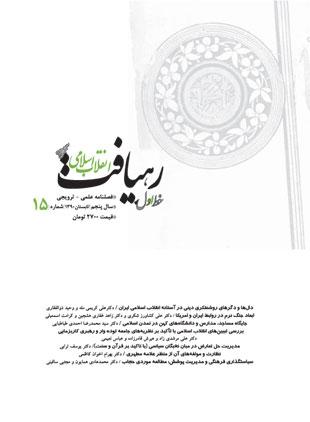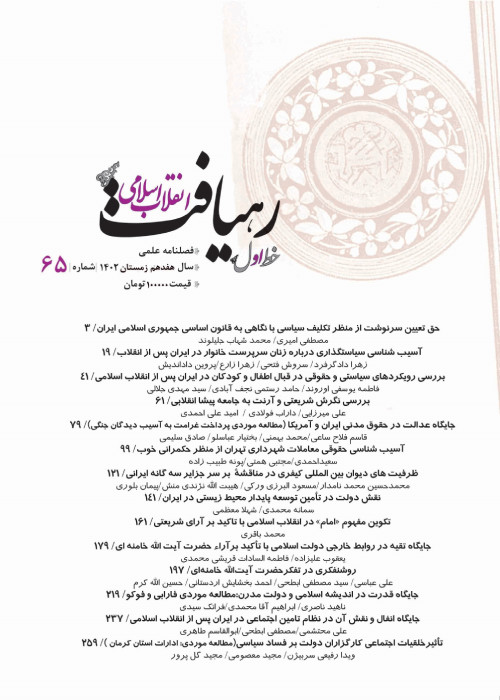فهرست مطالب

فصلنامه رهیافت انقلاب اسلامی
پیاپی 15 (تابستان 1390)
- بهای روی جلد: 27,000ريال
- تاریخ انتشار: 1390/07/30
- تعداد عناوین: 8
-
صفحه 152
-
Page 3Iran’s intellectual and political life in the post World War II period reflected an ideological conflict among various societal trends and forces. In the course of these confrontations, and in response to the domestic and foreign, intellectual and political necessities of this period, a new type of intellectual trend emerged, which had a religious nature and was located at the crossing of tradition and modernity. The rise of this new force can be considered as one of the most important developments in the Iranian political culture during the period. To obtain discursive hegemony, this new force turned to elaborating its discourse elements and delineating it from “Other” identities. This research focuses on the study of the “Other” from the viewpoint of this trend, taking into consideration the central signifiers of the religious intelligentsia. It tries to answer the question which factors constitute its central signifiers, as identity making elements, and which the main others of this social force are.
-
Page 29The main issue to explore in the present article is the dimensions of soft war between Iran and the United States. To answer this basic research question, Iran-US relationship is analyzed regarding the media, computer, domestic policy and foreign policy. With respect to the media, the two aforementioned countries manipulate their target society through media war tools including radio, television, etc and through media techniques as “highlighting” and thus strive to change their audiences’ point of view. In the field of computer, through establishing virtual social networks, making internet opposition, encouraging civil disobedience, internet thought provoking, etc, they struggle to penetra their target countries. Regarding domestic policy, through emphasizing on soft strategies in dealing with Iran, the US tries to build a yawning gap between Iran and Middle East Countries. With regard to foreign policy, three fields of tourism, nuclear power and human rights were emphasized. The US strategies and tactics in the domestic field involve making norms and making democracy.
-
Page 49Friday Mosques, religious schools and the ancient centers involved in the dissemination of knowledge and religion and culture in the Islamic world were in fact considered as the modern universities involved in the research on divine and human knowledge. In early Islam, mosques were used as public universities especially in the dissemination of divine knowledge, Qur’anic wisdom and intellectual and theologic issues. By the propagation of Islamic religion and monotheistic doctrines to different countries and through building Friday Mosques and diverse schools, the major part of the educational, ethical and scientific responsibilities all over the world were accomplished by mosques, especially Friday Mosques. The present research attempts to have brief look at the most prominent mosques, schools, houses of science, ancient libraries and scientific and medical centers which played a salient role in the dissemination of divine, natural and intellectual knowledge.
-
Page 67This article intends to analyze the explanations about Iranian revolution that are based on charismatic and mass society theories. The theoretical category of this article is based on theories of such theorists as Max Weber, Emile Dorkheim, and William Kornhouser. This article intends to make a linkage between these theories and the revolution. Therefore the explanations of Hoseini, and Hazeri are analyzed. Although in all of these explanations, both charismatic and mass society theories are explained, each of these analysts has stressed on one of these features.
-
Page 83Conflict, discord, and lack of unity and consensus among political factions and power elites in the Islamic Republic of Iran is a complicated problem for the country. How to rationally resolve and manage these differences has been a serious concern of the authorities in recent years. In this respect, Imam Khomeini (PBUH) identified the disunity and discord among the countries’ authorities as the single biggest threat to the nation, and frequently reminded the vital importance of unity. The most natural and concrete result of conflict and discord is the weakening of the parties to it, and the loss of fine and valuable opportunities for the progress and advancement of the country. Therefore, it is vitally necessary to study the methods, mechanisms and patterns of the management of conflict resolution, concerning which little academic literature is available. This study is a research endeavor regarding the patterns of managing conflict resolution with an emphasis on the Holy Quran and the Sunnah of the Infallible Imams (PBUT).
-
Page 109Monitor in Islam is believed to be a religious responsibility and is considered under the biding duty of enjoining the good and forbidding the evil and it is therefore of considerable significance in Islamic thoughts and doctrines. Allameh Martyr Motahari had a profound look at the issue of public supervision and especially at its salient aspect, enjoining the good and forbidding the evil. The present paper is therefore an attempt to define his main perspectives regarding public supervision is closely interwoven with enjoining the good and forbidding the evil, social responsibility and reform. He emphasizes the necessity of monitoring the rulers as a religious duty and religious considers the negligence of enjoining the good and forbidding the evil and its consequent social aspects as a serious threat. He discusses the chance of having an effect without causing any damage and believes that some of the indispensible and fundamental tools of enjoining the good and forbidding the evil include acquiring power and knowledge, logic, planning and social organizations.
-
Page 125Public policy-making is tightly interwoven with growth. Public growth is a comprehensive growth which involves cultural growth as its essential part and cultural policy-making is one of the tools of cultural growth. There are no common views on culture being influenced by policy. On the other hand, veil as the most prominent cultural symbol is tightly and mutually interwoven with culture and just as culture there are some disagreements in the field of public intervention. Government intervention is the common ground of the discussed issues in the field of culture and veil. On this basis, the two perspectives of free culture and controlled culture are being introduced, based on which, some consider veil to be a personal and private matter out of the realm of public domain and some consider it to be belong to the public domain. The present article, through investigating the possibility of culture being affected by policy, attempts to find out that either veil belongs to the public domain or to the private domain and it further analyzes and discusses the ways of government intervention.


